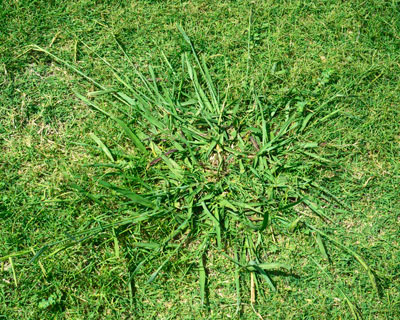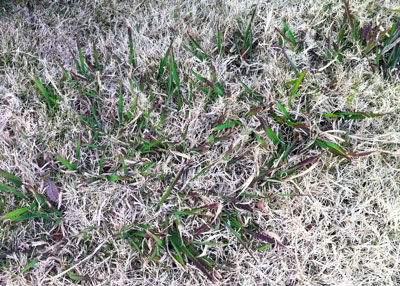Question of the Week – Number 1: August 13, 2020
“How can I identify dallisgrass, and if that’s what I have, how can I get rid of it?”
When MSMA was taken off the market 10 or 12 years ago, I turned to my wife and said, “Dallisgrass will soon be the state grass of Texas.” I figured it would run rampant, and it just about has.

To identify dallisgrass…
• It’s a perennial grass (comes back from its roots each spring).
• It establishes dense clumps the size of dinnerplates. It produces no runners.
• It has comparatively wide blades that are very dark green.
• Seed heads are visible within just 2-3 days after mowing. They stand 15-24 inches tall and resemble old-fashioned electric poles with cross-arms.

• Seeds are green discs arranged along each of the cross-arms. Each seed will have a small black, peppery speck attached to it.
• You won’t be able to tell it by looking, but each and every seed will be fertile, even without pollination. It’s a process called apomixis, and it ensures you a ready supply of seeds to keep you well populated.
To control dallisgrass…
MSMA used to be really effective in controlling dallisgrass within existing bermuda turf without harming the bermuda. (It did harm St. Augustine, however, so we couldn’t use it there. Now both grasses are on equal footing.)
Option 1: Dig out the clumps using a hand shovel. Sometimes, especially in St. Augustine, it’s difficult to differentiate the weeds from the turfgrass, but do the best you can. You’ll miss some of the dallisgrass, so be prepared to have a second digging. And a third.
Option 2: Someone posted on my Facebook page 8 or 9 years ago with a tip on how to address dallisgrass in a home lawn effectively without killing your desirable grass.
Cut the end out of a 1-gallon plastic milk jug. Take the lid off the jug and dispose of it.
Use a glyphosate-only weedkiller (no other active ingredients) mixed at spraying strength, and apply it with a pump sprayer.
Press the milk jug down firmly over the clump of dallisgrass. Insert the spray wand into the jug and spray the dallisgrass to coat its leaves. Carefully lift the jug and move on to the next clump.
Yes, you’ll have dead spots within the turfgrass, but healthy, vigorous grass will quickly fill back in. As long as you use a glyphosate-only product you will leave no herbicide residue in the soil.

A late-winter alternative…
Some winters, and in some parts of Texas, our permanent lawngrasses may go brown enough that you could take the chance of spot-spraying dallisgrass just as it starts to green up with the first warm days of very early spring. It will often put out green leaves a week or two before St. Augustine, bermuda and zoysia do, particularly in the northern half of the state.
Once again, I warn you that you are assuming all the risk in doing this. Also, you must be very careful to apply the weedkiller only to the weeds as much as is possible. Most especially, do not try this if your permanent grass has green runners and is starting to grow actively.
